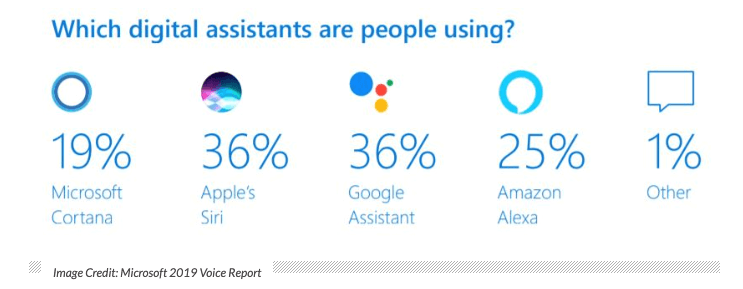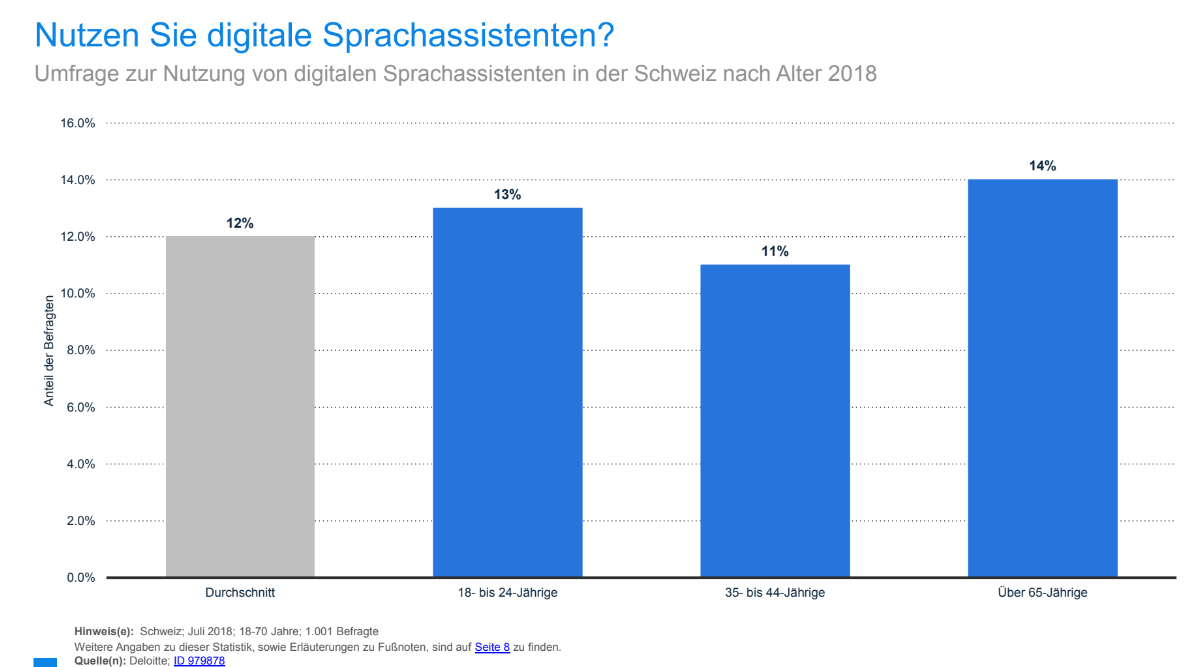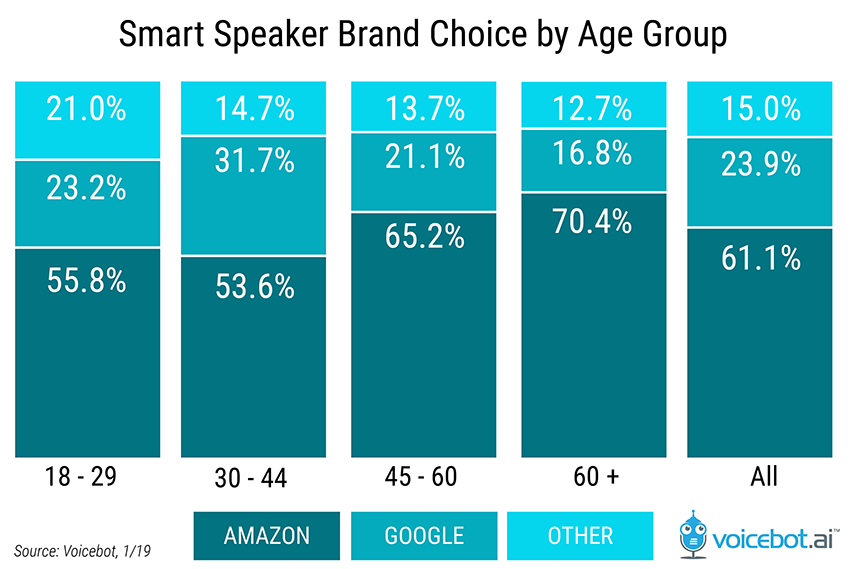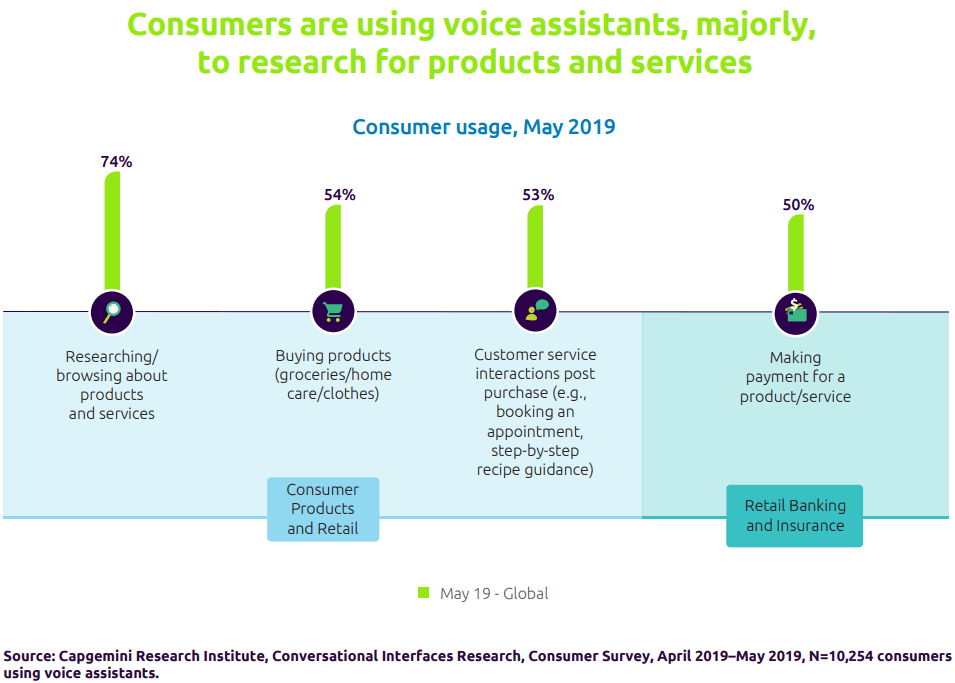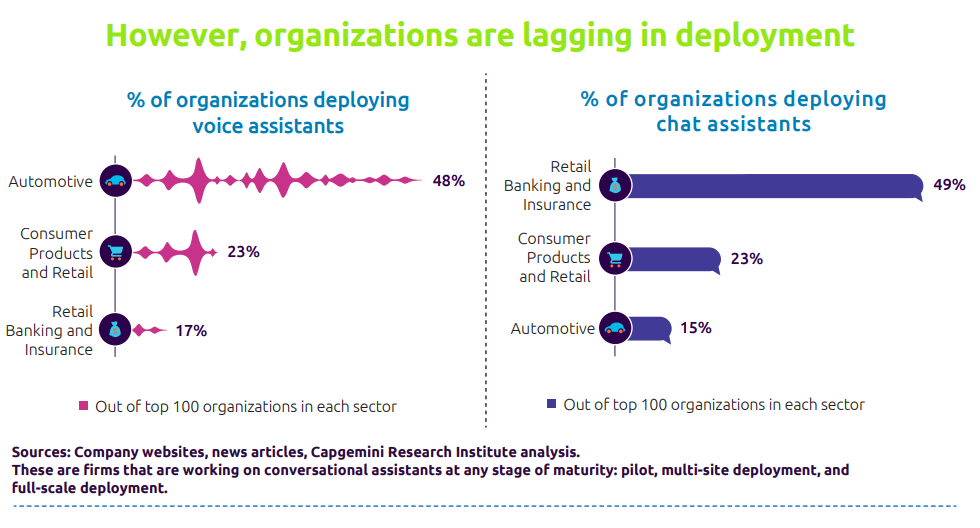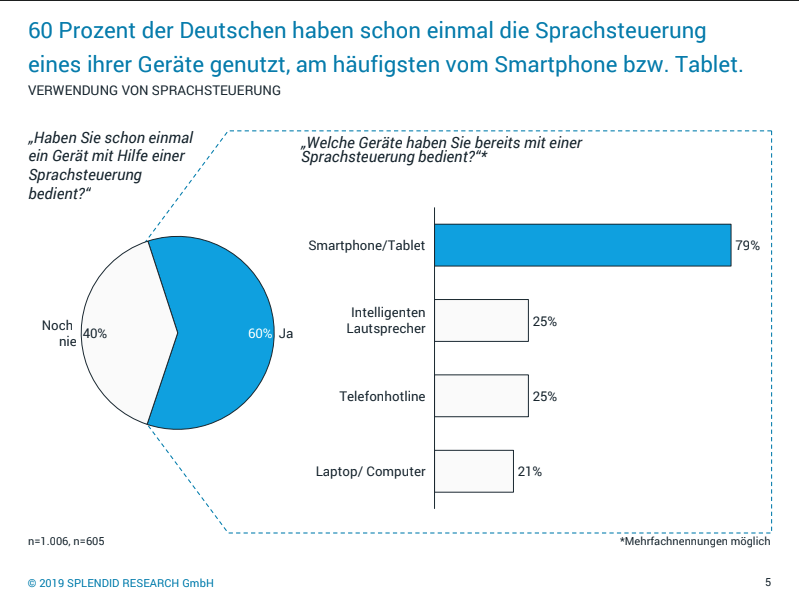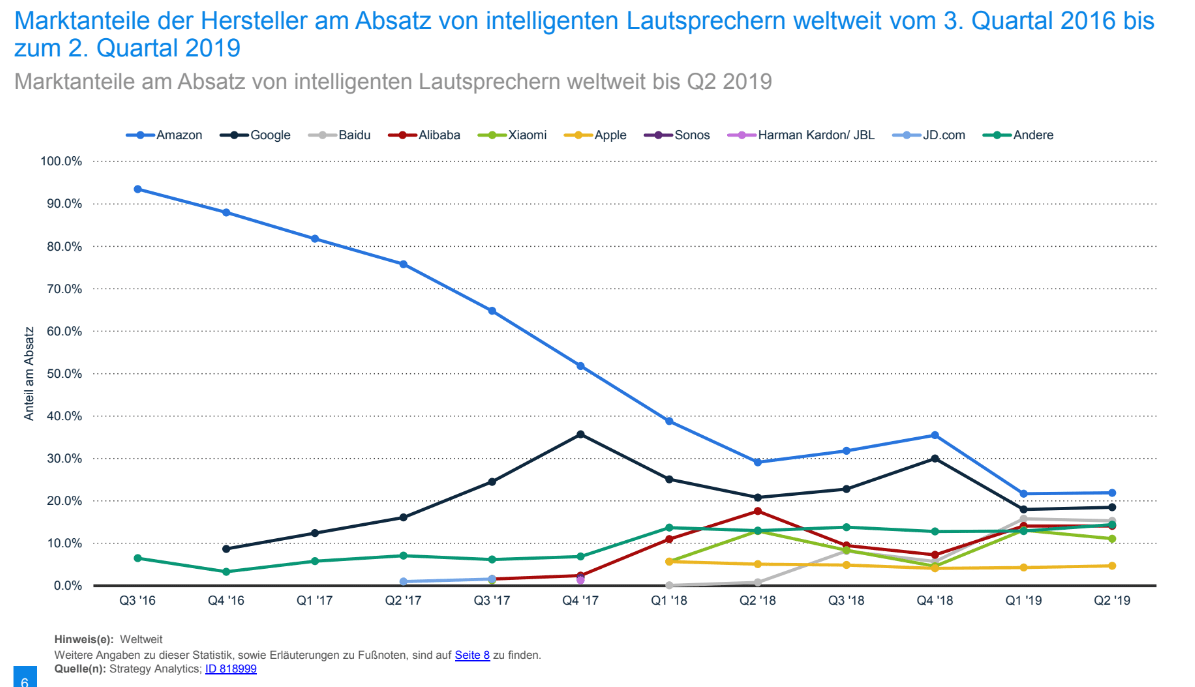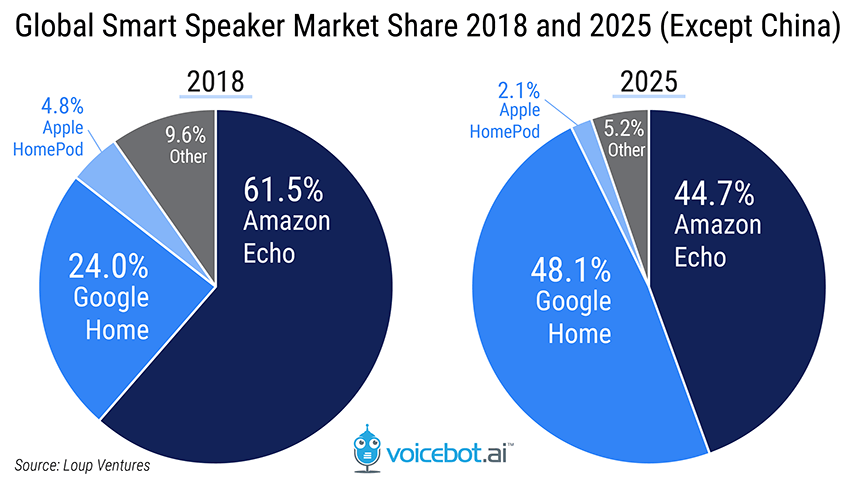Why Digital Assitants?
Nina Habicht • September 24, 2019
Why Voice Assistants?
Voice assistants also called voice user interfaces using text-to-speech and speech-to-text capabilities are gaining more relevance due to their technological progress in the fields of voice recognition engines (AVR), machine learning algorithms and architectural design.
What are the advantages of using voice instead of normal GUIs or text?
Speed.
Speaking is faster than writing. On average, people speak 150 words/minute. for search, voice can be useful: Search Engine Land considered voice assistants as taking over a “critical mass” with 122,7 million users in 2021. According to ComCore, 50% of searches will be done by voice and 30% of web browsing sessions will be done without a screen until 2020.
Voice is more natural.
Emotions, needs, and wishes will be articulated in more detail which offers the company a better picture of how customer’s needs look like.
Brand Recognition.
Voice creates a new channel for delivering a brand.
Handsfree.
In any situation where handsfree is useful, voice is ideal, i.e. when shopping with children, when driving, when cooking, when industrial workers are picking, when surgeons are operating, etc. There are various use cases where voice very useful. Furthermore, people with disabilities can “talk” to message with friends, shop or execute tasks before writing was omnipresent.
Which Voice Assistants are used?
Source: Usage of Digital Assistants (Microsoft Voice Report, 2019)
Who uses Voice Assistants?
All age groups use assistants, however, we find that in Switzerland as well as internationally Millennials and Seniors using more voice assistant or speakers than the age group between 35-44. Interesting is the fact, that older generations more frequently use Amazon Alexa. 1/3 of the total US population use voice assistants at least monthly on a device (eMarketer, 2019). In Germany, out of 605 person, 30% use it more than weekly, 30% monthly (Splendid Research, 2019).
Source: Switzerland Voice Assistant Usage per Age Group (Deloitte, 2018)
Source: Smart Speaker Brand Choice by Age Group (Voicebot.ai, 2019)
In which fields are Digital Assistants used?
Capgemini’s showed in a study with 12’000 consumers and 1000 executives who used voice or text assistants (or both) that 50% of the key players, especially in the fields of automotive, banking, insurances and consumer products have deployed first voice or chat assistants.
Source: Use Cases of Digital Assistants (Capgemini Research Institute, 2016-19)
In which fields are chatbots vs. voice applications?
Source: Chatbot vs. Voice Assistant Use Cases (Capgemini Research Institute, 2016-19)
Voice Assistants on Smartphones and Smart Speakers?
According to Splendid Research German users are currently more likely to use smartphones with assistants than Smart Speakers. In Switzerland and Austria, we see the same usage pattern. However, this highly depends on the age group and technology provider (Cortana does not have a smart speaker). Voice assistants are also implemented in other devices, such as wearables, smartwatches, and TVs.
Source: 60% of the Germans already used Voice Assistants on these devices (Splendid Research, 2019
Which Technology Providers are the Market Leaders?
When looking at the global market shares of smart speakers, Strategy Analytics finds Amazon, Google and Baidu to be the global leaders. By 2019 Google has 1 billion Google Assistant
enabled devices whereas Amazon 100 million enabled devices according to their market share announcements in January 2019. According to Venturebeat Cortana has 500 million active monthly users
on Windows 10 PCs and "tens of millions of users on Xbox". Siri from Apple has over 500 million active users
in 2018.
Source: Development of Major Global Voice Tech Players (Strategy Analytics, 2019)
In Switzerland, Siri seems to be still dominant, followed by Google Home and Amazon. Finally, various sources clearly announce a shift to Google Assistant, also for Switzerland and Europe.
Source: Swiss people know and use Siri and Google Home (Mcschindler.com, 2019)
Source: Shift from Amazon to Google Technologies (Voicebot.ai, 2019)
Need support with your Generative AI Strategy and Implementation?
🚀 AI Strategy, business and tech support
🚀 ChatGPT, Generative AI & Conversational AI (Chatbot)
🚀 Support with AI product development
🚀 AI Tools and Automation


Should I use several AI tools or stick to one platform? That's a question I often hear from clients. 𝐓𝐡𝐞 𝐫𝐞𝐚𝐥 𝐚𝐧𝐬𝐰𝐞𝐫? 𝐈𝐭 𝐝𝐞𝐩𝐞𝐧𝐝𝐬 𝐨𝐧 𝐲𝐨𝐮𝐫 𝐮𝐬𝐞 𝐜𝐚𝐬𝐞. Ask yourself: What problem are you trying to solve? Our guideline to be successful with your AI tool journey 1. Start by exploring a few major large language model platforms (ChatGPT, Gemini, Claude, etc.). - Gemini -> Amazing multimodality, images - ChatGPT -> Swiss Knife for AI, great for coding, logical and analytical tasks. - Claude -> Psychological, enhanced writing and strong with coding 2. Once you’ve defined your use case, commit to one main tool and consider upgrading to a paid version for the full experience. Still continue experimenting with specialised tools for certain tasks, so you learn, get ideas and can depriorize certain use cases. 3. Most importantly, invest in learning prompt engineering and focus on solving real problems that deliver value for you or your business and your clients. Sometimes, you don’t even need AI!

AI-powered chatbots, whether developed in-house or deployed through trusted platforms, are revolutionizing customer service, knowledge access, and internal communication. However, alongside these opportunities come new legal obligations: data protection , transparency , and EU AI Act compliance must be addressed carefully. This article covers: Where AI chatbots bring business value What compliance risks you must manage How to implement AI chatbots successfully and securely

Since August 2024, users have been able to use the web version of the image creation tool Midjourney. This simplifies usage by providing a user-friendly interface to experiment with one of the top Generative AI image creation tools available. We tested it for you and are sharing helpful tips and tricks. How to prompt images with Midjourney? If you use Midjourney on discord, there is a clear prompt structure and prompt parameters to adhere to. Usually, it makes sense to stick to it: 1) To prompt use "/Imagine" 2) Then enter your subject (description and details) you want to see on the image and it's environment (see yellow highlighted below in the prompt example) 3) Then enter composition, lightning, colours (see green highlighted below in the prompt example) 4) Finally add technical parameters to adjust and finalize your image. Please find a useful parameter library here.




